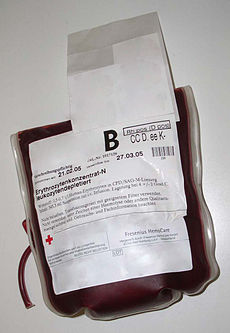การถ่ายเลือด โดยทั่วไปเป็นกระบวนการรับผลิตภัณฑ์ของเลือด เข้าระบบไหลเวียน ของบุคคลเข้าหลอดเลือดดำ การถ่ายเลือดใช้ในภาวะการแพทย์ต่าง ๆ เพื่อทดแทนส่วนประกอบของเลือดที่เสียไป การถ่ายเลือดช่วงแรก ๆ ใช้เลือดเต็ม แต่เวชปฏิบัติสมัยใหม่ทั่วไปใช้เฉพาะบางองค์ประกอบของเลือดเท่านั้น เช่น เม็ดเลือดแดง เม็ดเลือดขาว น้ำเลือด ปัจจัยจับลิ่มของเลือด (clotting factor) และเกล็ดเลือด
ในอดีต การถ่ายเม็ดเลือดแดงพิจารณาเมื่อระดับฮีโมโกลบิน ต่ำกว่า 10 กรัมต่อเดซิลิตร หรือปริมาตรเม็ดเลือดแดงในเลือด (ฮีมาโทคริต) ต่ำกว่า 30% ("กฎ 10/30")[ 1] [ 2] [ 3] [ 3] [ 3] ภาวะเลือดจาง ที่่อนข้างรุนแรงเท่านั้น ส่วนหนึ่งจากหลักฐานว่าผลลัพธ์เลวลงหากให้เลือดปริมาณมากขึ้น[ 4] โรคหัวใจหลอดเลือด เช่น เจ็บอกหรือหายใจสั้น[ 2] [ 5]
↑ Adams RC, Lundy JS: Anesthesia in cases of poor surgical risk. Some suggestions for decreasing risk. Surg Gynecol Obstet 1942; 74:1011–1019.
↑ 2.0 2.1 Carson, JL; Grossman, BJ, Kleinman, S, Tinmouth, AT, Marques, MB, Fung, MK, Holcomb, JB, Illoh, O, Kaplan, LJ, Katz, LM, Rao, SV, Roback, JD, Shander, A, Tobian, AA, Weinstein, R, Swinton McLaughlin, LG, Djulbegovic, B, for the Clinical Transfusion Medicine Committee of the, AABB (Mar 26, 2012). "Red Blood Cell Transfusion: A Clinical Practice Guideline From the AABB". Annals of internal medicine . doi :10.1059/0003-4819-156-12-201206190-00429 (inactive 2015-01-10). PMID 22454395 . {{cite journal }}: CS1 maint: DOI inactive as of มกราคม 2015 (ลิงก์ ) CS1 maint: multiple names: authors list (ลิงก์ )↑ 3.0 3.1 3.2 American Association of Blood Banks (24 April 2014), "Five Things Physicians and Patients Should Question" , Choosing Wisely : an initiative of the ABIM Foundation , สืบค้นเมื่อ 25 July 2014 ↑ Villanueva, C; Colomo, A; Bosch, A; Concepción, M; Hernandez-Gea, V; Aracil, C; Graupera, I; Poca, M; Alvarez-Urturi, C; Gordillo, J; Guarner-Argente, C; Santaló, M; Muñiz, E; Guarner, C (2013). "Transfusion strategies for acute upper gastrointestinal bleeding" . The New England Journal of Medicine . 368 (1): 11–21. doi :10.1056/NEJMoa1211801 . PMID 23281973 . ↑ Gasche, C; Berstad, A; Befrits, R; Beglinger, C; Dignass, A; Erichsen, K; Gomollon, F; Hjortswang, H; Koutroubakis, I; Kulnigg, S; Oldenburg, B; Rampton, D; Schroeder, O; Stein, J; Travis, S; Van Assche, G (2007). "Guidelines on the diagnosis and management of iron deficiency and anemia in inflammatory bowel diseases" (PDF) . Inflammatory bowel diseases . 13 (12): 1545–53. doi :10.1002/ibd.20285 . PMID 17985376 .
Information related to การถ่ายเลือด





